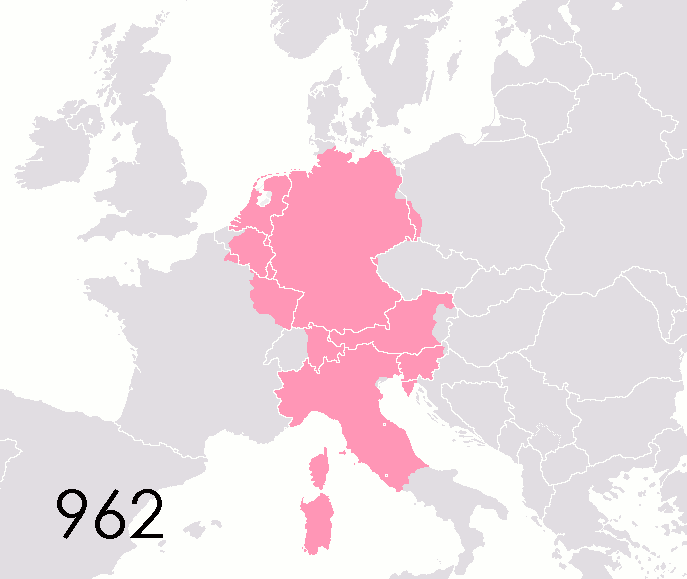German History Timeline
To understand our German family history, I feel it’s important to understand the geography of where they lived and the history of the time they lived in. The following is just a short timeline of Germany History and a bit about Religion. The map is the Holy roman Empire from 962 to 1806 superimposed on present day borders.

Early German History
800 – Emperor Charlemagne, Frankish ruler of France and Germany, crowned Roman emperor by Pope Leo III.
843 – Break-up of Frankish empire; Germany emerges as separate realm.
962 – German King Otto I crowned Roman emperor after gaining control of northern Italy; beginning what became known as Holy Roman Empire centered on Germany.
1250 – Death of Emperor Frederick II Hohenstaufen marks virtual end of central authority and acceleration of empire’s collapse into independent princely territories.
1438 – Election of Albert I marks beginning of Habsburg dynasty based in Austria.
1512 – The Empire’s title changed to the Holy Roman Empire of the German Nation.
1517 – Martin Luther proclaims Ninety-Five Theses against traditional church practices; start of Protestant split from Catholic Church.
Early Modern Germany
1618-1648 – Thirty-Years’ War; failure of Habsburg emperors’ attempt to restore Catholic dominance and imperial authority against opposition of Protestant princes; 1648 Treaty of Westphalia confirms near total independence of Territorial states.
1806 – Napoleon’s armies impose French rule over much of Germany; Francis II declares abolition of Holy Roman Empire and adopts title of emperor of Austria.
1813 – Defeat of Napoleon at Battle of Leipzig.
1848 – Year of Revolutions; failure of liberals’ attempt to unite Germany under democratic constitution; start of period of rapid industrialization.
1871 – Otto von Bismarck achieves unification of Germany under leadership of Prussia; new German Empire’s authoritarian constitution creates elected national parliament but gives emperor extensive powers.
1888 – Start of William II’s reign; start of trend towards colonial expansion and build-up of navy to compete with Britain’s; rapid growth of economic power.
1890 – Growing worker’s movement culminates in founding of Social democratic Party of Germany.
1914—1918 – World War I.
1918 – Germany defeated, signs armistice. Emperor William II abdicates and goes into exile.
1919 – Treaty of Versailles; Germany loses colonies and land to neighbors, pays large-scale reparations.
Beginning of the Weimar Republic, based on new constitution. Its early years are marked by high unemployment and rampant inflation.
1923 – Adolf Hitler, head of the National Socialist German Workers’ (Nazi) Party, leads an abortive coup in a Munich beer hall.
France, Belgium occupy the Ruhr over failed reparation payments. Hyperinflation leads to economic collapse.
1929 – Global depression, mass unemployment.
1939–1945 – World War II.
Religion
Religion contributed to the cause of many wars and was not always the choice of the people. Roman Catholicism constituted the single official religion of the Empire until 1555. The Holy Roman Emperor was always a Roman Catholic. Lutheranism was officially recognized in the Peace of Augsburg of 1555, and Calvinism in the Peace of Westphalia of 1648. Those two constituted the only officially recognized Protestant denominations, while various other Protestant confessions such as Anabaptism, Arminianism, etc. coexisted illegally within the Empire. Anabaptism came in a variety of denominations, including Mennonites, Schwarzenau Brethren, Hutterites, the Amish, and multiple other groups.
Following the Peace of Augsburg, the official religion of a territory was determined by the principal Cuius regio, eius religio (literally means “whose realm, his religion”) according to which a ruler’s religion determined that of his subjects. The Peace of Westphalia (1648) abrogated that principle by stipulating that the official religion of a territory was to be what it had been on January 1, 1624, considered to have been a “normal year”. Henceforth, the conversion of a ruler to another faith did not entail the conversion of his subjects. In addition, all Protestant subjects of a Catholic ruler and vice versa were guaranteed the rights that they had enjoyed on that date.
While the adherents of a territory’s official religion enjoyed the right of public worship, the others were allowed the right of private worship (in chapels without either spires or bells). In theory, no one was to be discriminated against or excluded from commerce, trade, craft or public burial on grounds of religion. For the first time, the permanent nature of the division between the Christian Churches of the empire was more or less assumed.
- Holy Roman Empire, from 692 to 1806.. By Jaspe, CC BY-SA 3.0, https://commons.wikimedia.org/w/index.php?curid=2996384
